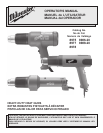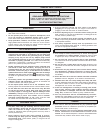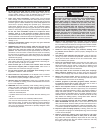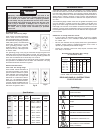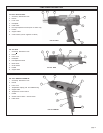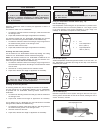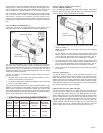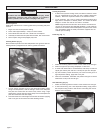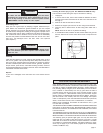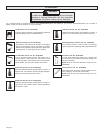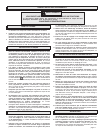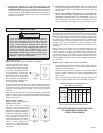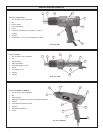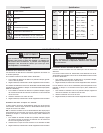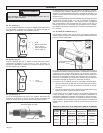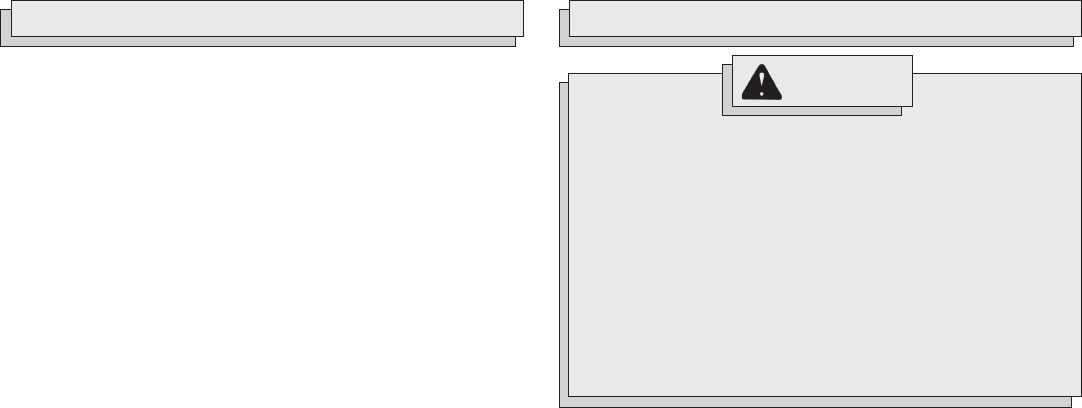
page 3
SPECIFIC SAFETY INSTRUCTIONS HEAT GUNS
1. Do not direct the heat gun air airflow at clothing, hair or
other body parts. Do not use as a hair dryer. Heat guns can
produce 1000°F (540°C) or more of flameless heat at the nozzle.
Contact with the air stream could result in personal injury.
2. Know your work environment. Hidden areas such as behind
walls, ceilings, floors, soffit boards and other panels may contain
flammable materials that may ignite when using the heat gun in these
locations. Ignition of these materials may not be readily apparent and
could result in property damage and personal injury. Check these
areas before applying heat. If in doubt, use an alternate method.
Pausing or lingering in one spot may ignite the panel or the material
behind it. Keep heat gun moving to avoid excessive temperatures.
3. Do not use near flammable liquids or in explosive atmo-
spheres, such as in the presence of fumes, gases or dust.
The flameless heat from the heat gun may ignite the dust or fumes.
Remove materials or debris that may become ignited from work area.
4. Shield materials around the heated area to prevent property
damage or fire.
5. Keep a fire extinguisher nearby. Heat guns may ignite flammable
materials left in the work area.
6. WARNING! Hot Surfaces. Always hold the heat gun by the
plastic enclosure. Do not touch nozzle, accessory tips or
store heat gun until the nozzle has cooled to room tem-
perature. The metal nozzle requires approximately 20 minutes to
cool before it can be touched. Contact with the nozzle or accessory
tip could result in personal injury. Place the heat gun in a clear area
away from combustible materials while cooling to prevent flammable
materials from igniting.
7. Do not cut off airflow by placing nozzle too close to workpiece.
Keep intake vents clean and clear of obstructions. Restricting air-
flow may cause the heat gun to overheat.
8. Place the heat gun on a stable, level surface when not hand
held. Use the support pads or support stand. Place cord in a
position that wont cause the heat gun to tip over.
9. Do not leave the heat gun unattended while running or cool-
ing down. Inattention invites accidents.
10. Store indoors in a dry location. Do not expose to rain or moisture.
11. Do not direct airflow directly on glass. The glass may crack and
could result in property damage or personal injury.
12. Maintain labels and nameplates. These carry important informa-
tion. If unreadable or missing, contact a MILWAUKEE Service facil-
ity for a free replacement.
13. WARNING! Some dust created by power sanding, sawing, grinding,
drilling, and other construction activities contains chemicals known
to cause cancer, birth defects or other reproductive harm. Some
examples of these chemicals are:
lead from lead-based paint
crystalline silica from bricks and cement and other masonry prod-
ucts, and
arsenic and chromium from chemically-treated lumber.
Your risk from these exposures varies, depending on how often you
do this type of work. To reduce your exposure to these chemicals:
work in a well ventilated area, and work with approved safety equip-
ment, such as those dust masks that are specially designed to filter
out microscopic particles.
SAFETY INSTRUCTIONS FOR REMOVING PAINT
1. Work in a well ventilated area. If possible, move the workpiece
outdoors. If working indoors, open windows and place an exhaust
fan in a window. Be sure the fan is moving air from inside to outside.
Proper ventilation will reduce the risk of inhaling chemicals found in
the fumes or dust created by using a heat gun.
2. Remove or cover any carpets, rugs, furniture, clothing, cook-
ing utensils and air ducts to prevent property damage from the
paint peelings.
3. Use caution when operating the heat gun. Keep the heat gun
moving to prevent excessive temperatures. Excessive heat can
cause paint and other materials to burn and cause fumes, which
may be inhaled by the operator.
4. Keep work environment clean. Keep food and drink away from
work area. Wash hands, arms and face and rinse mouth before
eating and drinking. Do not smoke, or chew gum or tobacco in the
work area. Paint scrapings and dust created from removing paint
may contain chemicals that are hazardous.
5. Place drop cloths in the work area to catch paint scrapings.
Wear protective clothing such as hats, extra work shirts and
overalls. Paint scrapings may contain chemicals that are hazardous.
6. Work in one room at a time. Remove furnishings or cover them
and place in the center of the room. Seal doorways with drop cloths
to seal work area from the rest of the building.
7. Children, pregnant or potentially pregnant women, and nurs-
ing mothers should not be near work area until all work is
completed and work area is cleaned thoroughly.
8. Wear a dust respirator mask or a dual filter (dust and fume)
respirator mask which has been approved by the Occupational
Safety and Health Administration (OSHA), the National Institute of
Safety and Health (NIOSH), or the United States Bureau of Mines.
These masks and replaceable filters are readily available at major
hardware stores. Be sure the mask fits. Beards and facial hair may
keep masks from sealing properly. Change filters often. DISPOS-
ABLE PAPER MASKS ARE NOT ADEQUATE.
9. Clean up all paint scraping and dust. DO NOT SWEEP, DRY
DUST OR VACUUM. Wet mop floors. Use a wet cloth to clean all
walls, sills and other surfaces where paint and dust have accumu-
lated. Use a high phosphate detergent, trisodium phosphate (TSP),
or a trisodium phosphate substitute to clean and mop the work area.
10. Dispose of paint scrapings properly. Following each work ses-
sion, place paint scrapings in a double plastic bag, close it with tape
or twist ties and dispose.
11. Remove protective clothing and work shoes in the work
area to avoid transferring dust to other parts of the build-
ing. Wash work clothes separately. Wipe shoes off with a wet rag
that is then washed with the work clothes. Wash hair and body
thoroughly with soap and water.
WARNING!
Use extreme care when stripping paint. Peelings, residue
and vapors of paint may contain lead, which is POISONOUS.
Pre-1977 paint may contain lead and paint made
before 1950 is likely to contain lead. Hand to mouth contact
with paint peelings or residue from pre-1977 paint may
result in lead ingestion. Exposure to even low levels of lead
can cause irreversible brain and nervous system damage.
Young and unborn children are especially vulnerable to
lead poisoning. DO NOT REMOVE LEAD-BASED PAINT WITH
A HEAT GUN. Before beginning your work, determine
whether the paint you are removing contains lead. A local
health department or a professional who uses a paint
analyzer can check the paint for lead content. LEAD-BASED
PAINT SHOULD BE REMOVED ONLY BY A PROFESSIONAL.



